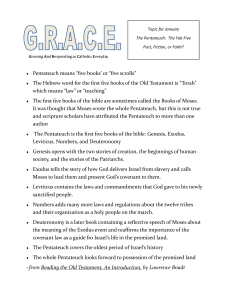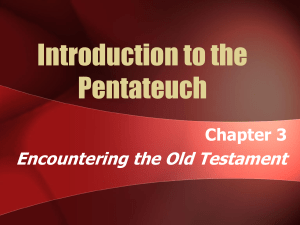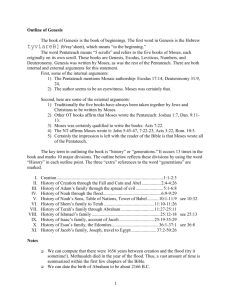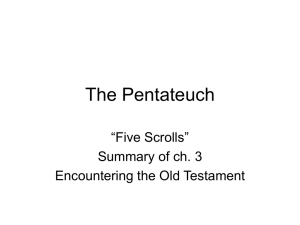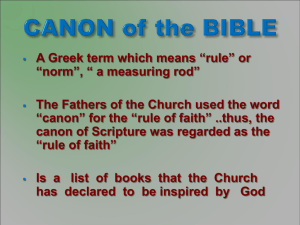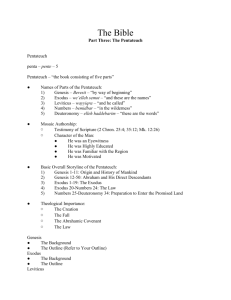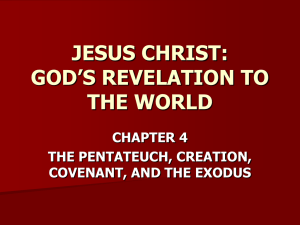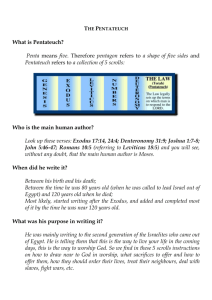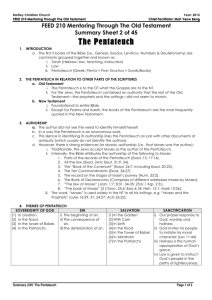Lecture notes in PPT - Lakeside Institute of Theology
advertisement
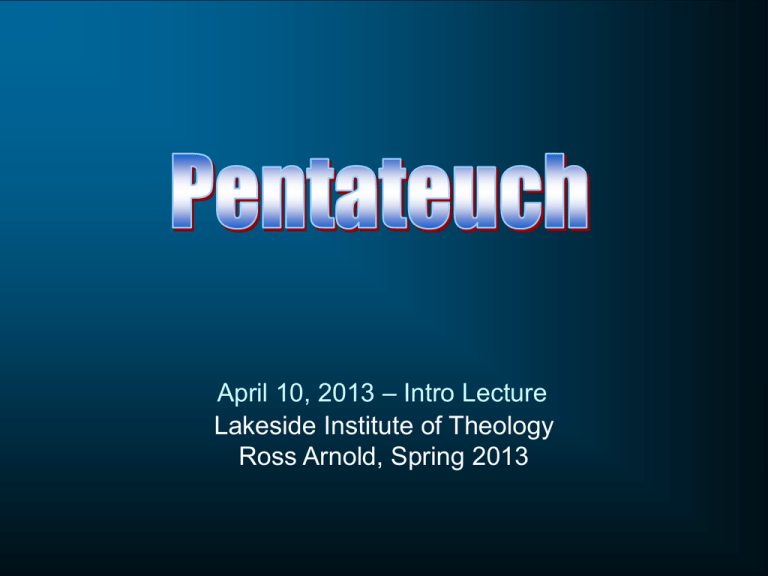
April 10, 2013 – Intro Lecture Lakeside Institute of Theology Ross Arnold, Spring 2013 Policies and Requirements 1. Classes are free, but all students seeking a certificate or degree must purchase books (paper, not electronic), which will be made available by the Institute. 2. Students in certificate or degree tracks may miss no more than one class per course, without arrangements made in advance with the teacher to make up missed work (at the discretion of the teacher). 3. Students in certificate or degree tracks will be required to take a pass/fail final exam in each course, based on study guidelines provided by the teacher. 4. Students in certificate or degree tracks must make a passing grade (based on "pass/fail") in each course in order to receive credit towards a certificate or degree. 5. Candidates for degrees (Master of Theology and Master of Theology & Ministry) must be approved by the Institute Director before final admission into a degree program. Pentateuch (OT3) 1. 2. 3. 4. 5. 6. 7. 8. Introduction to the Pentateuch Genesis 1-11; The Prehistoric Prologue Genesis 12-50; The Patriarchs Exodus 1-18; God’s Deliverance Exodus 19-40’ The Covenant at Sinai Leviticus Numbers Deuteronomy; Final Exam On what do we base our faith? • Our beliefs are based on God’s own revelation to us, as given in four ways (in descending order of authority): 1. The revelation of God in Scripture. 2. The revelation of God to His Church, down through history. 3. The revelation of God in the world. (“General Revelation”) 4. The revelation of God to individual people. We believe the Bible is God’s Word… – Revealed This is what the LORD, the God of Israel, says: 'Write in a book all the words I have spoken to you. Jeremiah 30:2-3 – Inspired All Scripture is God-breathed and is useful for teaching, rebuking, correcting and training in righteousness, 17 so that the man of God may be thoroughly equipped for every good work. 2 Tim. 3:16-17 – Authoritative For what I received I passed on to you as of first importance: that Christ died for our sins according to the Scriptures, 4 that he was buried, that he was raised on the third day according to the Scriptures, 5 and that he appeared to Peter, and then to the Twelve. 1 Corinthians 15:3-5 – Living For the word of God is living and active. Sharper than any double-edged sword, it penetrates even to dividing soul and spirit, joints and marrow; it judges the thoughts and attitudes of the heart. Hebrews 4:12 Structure & Form of the Old Testament Traditional Protestant Structure: – 39 Books in Four Sections: The Law (5) – “Torah” in Hebrew; “Pentateuch” or “Five Books” History (12) – Joshua thru Esther. Wisdom (5) – Job thru Song of Songs. Prophesy (17) – Isaiah thru Malachi, (sometimes broken up into Major Prophets: Isaiah thru Daniel, and Minor Prophets: Hosea thru Malachi) Structure & Form of the Old Testament Traditional Jewish Structure: – 24 Books in Three Sections: The Law (5) – “Torah” in Hebrew; Prophets (8) – “Nevi’im” in Hebrew Writings (11) – “Ketuvim” in Hebrew. Together these sections form the acronymn TaNaKh, or Hebrew Bible. (also known as “Miqra” or “that which is read”) Why Study the Old Testament? 1. It is the “Scriptures” referred to by Jesus and the Apostles. 2. The Old Testament is part of God’s inspired revelation to us. 3. The Old Testament is foundational to our understanding. 4. The Old Testament is practical. 5. The Old Testament points to Jesus Christ. The First Five Books of the Old Testament Torah Hebrew: “Law,” or “Instruction” Pentateuch Greek: “Five Books,” or “Five-Part Book” The Pentateuch – “Five Books” or “The Five-Fifths of Moses” • Genesis – bereshith, (“In the beginning”); from Greek • • • • Geneseos, “History of origins” Exodus – we’elleh shemoth, (“These are the names of”); from Greek Exodos, “Exit” Leviticus – wayyiqra, (“And the Lord called”); from Greek Leuitikos for “Relating to the Levites” Numbers – bemidbar, (“In the dessert”); from Greek Arithmoi referring to census lists, chapters 1 & 26 Deuteronomy – ‘elleh haddebarim, (“These are the words”); from Greek Deuteronomion or “2nd Repetition of the Law” Genesis From creation, thru the origins of God’s people to Egypt Exodus Relates God’s deliverance of Israel from Egypt and establishing His covenant/Law Leviticus Sets forth the Laws of worship Numbers Relates the wilderness wanderings Gives the Law to a new generation with special Deuteronomy emphasis to those entering the land Importance of the Pentateuch • It tells us where we (and the entire universe) came from. • It tells us what is wrong with us. • It reveals to us the nature of God – Creator, Redeemer, Righteous, Loving, Forgiving… • It gives us our history, through the history of God’s call and relationship with His chosen people. • It sets the stage for all that is to come – especially in Jesus and the New Testament. Authorship & Dating • Why authorship & dating of Pentateuch is important. • The testimony to Mosaic authorship c.1450-1400 BC. – In the Pentateuch itself: • Exodus 17:14, 24:4, 34:27; Numbers 33:1-2; Deuteronomy 4:44, 28:58, 31:9-13, 32:44-47; etc. – In other Old Testament books: • Joshua 1:7-8, 8:31, 22:5, 23:6; 1 Kings 2:3, 10:31; 2 Kings 14:6, 21:8, 23:25; Daniel 9:11-13; plus MANY more and MANY direct quotes from the Pentateuch. – In the New Testament: • Matt. 22:24, 31; Mark 12:19, 26; Luke 19:29, 20:28, 37, John 5:45-47; Acts 3:22, 13:13, 15:21, 28:23; Romans 10:5-8, 19; 1 Cor. 9:9; Revelation 15:3. – Unanimous witness in Jewish/Christian traditions. Documentary Hypothesis • Julius Wellhausen (1899) and others, mostly Germans, 18th through late 19th century, developed the theory that the Pentateuch was the product of at least FOUR (and perhaps as many as ten or more) different writers, NONE of whom were Moses, and all of whom came much later. – “J” – Yahwist source, c. 950 BC, Kingdom of Judah. – “E” – Elohist source, c. 850 BC, Kingdom of Israel. – “D” – Deuteronomist source, c. 600 BC, Jerusalem. – “P” – Priestly source, c. 500 BC, Jewish priests in exile in Babylon. Prejudices Behind the Documentary Hypothesis 1. “Moses could not have written the Pentateuch because writing was developed much later and therefore Moses could not write.” Proven wrong: we now have examples of writing far earlier, and Semitic writing in Egypt from as early as at least 1800 BC–long before Moses in 1400 BC. 2. “The idea of the Torah (or any part of the Bible) being inspired and/or protected by God as His revelation must be rejected outright, as does any suggestion of miraculous events.” This would undermine all Judaism and Christianity, as both faiths are built on the belief in God’s revelation in Scripture. Prejudices Behind the Documentary Hypothesis 3. “Differences in the text of the Pentateuch – different names for God, parallel stories, differences in style – require multiple authors.” Subsequent scholarship into Semitic writing styles has shown these variables to be quite normal, and belief in Moses as the primary writer of the Pentateuch does not mean NO other sources were used by Moses, nor does it mean minor additions could not have been added later by Joshua or others (such as the reference to Moses’ death). Conclusions Regarding Mosaic Authorship 1. The critical arguments against Mosaic authorship are insufficient to set aside the manifold testimony of both Old and New Testaments, the continuous consensus of both Jewish and Christian people for over 3000 years, and the internal consistencies of the text itself. 2. The Mosaic authenticity of the Pentateuch does not mean Moses could not have drawn on previous sources (as in the stories of Genesis), nor does it mean he might not have entrusted some of the writing to others under his direction, or that minor additions by other inspired writers (such as Joshua or Ezra) might not have been added later to complete the inspired narrative. The Book of Genesis • Author: Moses • Date: c. 1450 BC - 1400 BC • Theme: Beginnings – of the universe, the human race, and the Jewish people. • Purpose: To show that the Creator God is sovereign and loves His creation. • Outline: 1. Prehistoric Prologue: (chs. 1-11) Creation, Fall, Flood, Babel 2. The Hebrew People (11-50) * Father Abraham (11-25) * Isaac and Jacob (25-36) * Joseph (37-50) The Book of Exodus Author: Moses circa 1446 BC - 1440 BC Date: Theme: God’s deliverance of His Chosen people. Key Word: Redemption Purpose: To show God’s faithfulness to His covenant & give directions for living. Outline: 1. God’s Redemption Moses (chs. 1-7) The Plagues (7-13) The Exodus from Egypt (14-18) 2. God’s Covenant The Law (19-24) Tabernacle & Worship (25-40) The Book of Leviticus Moses c. 1445 BC-1400 BC Explanations of Law & Sacrifice. Key Word: Holiness Purpose: To instruct Israel on how to be holy & to be a blessing to others. Author: Date: Theme: Outline: Sacrifice (chs. 1-7) Priesthood (8-10) Clean and unclean (11-15) Day of Atonement (16) Laws for daily life (17-27) The Book of Numbers Moses c. 1445 BC-1400 BC Census and History Key Word: Wanderings Purpose: Show what can happen when God’s people rebel against Him. Outline: Census (chs. 1-9) Sinai to Canaan (10-12) Spies and Rebellion (13-19) At Moab (20-36) Author: Date: Theme: The Book of Deuteronomy Moses c. 1401 BC-1400 BC Three Sermons by Moses Key Word: Covenant Purpose: To remind the people of what God expects from them. Outline: Sermon 1: Journey reviewed (1-4) Sermon 2: Laws reviewed (5-28) Sermon 3: Covenant (29-30) Final Farewells (31-34) Author: Date: Theme:
